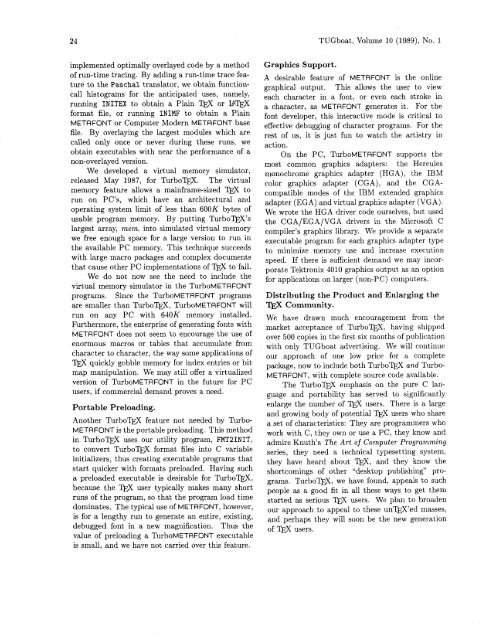Complete issue 10:1 as one pdf - TUG
Complete issue 10:1 as one pdf - TUG
Complete issue 10:1 as one pdf - TUG
You also want an ePaper? Increase the reach of your titles
YUMPU automatically turns print PDFs into web optimized ePapers that Google loves.
24 <strong>TUG</strong>boat, Volume <strong>10</strong> (1989), No. 1<br />
implemented optimally overlayed code by a method<br />
of run-time tracing. By adding a run-time trace feature<br />
to the P<strong>as</strong>chal translator, we obtain functioncall<br />
histograms for the anticipated uses, namely,<br />
running INITEX to obtain a Plain 'J&X or IPm<br />
format file, or running INIMF to obtain a Plain<br />
METAFONT or Computer Modern METAFONT b<strong>as</strong>e<br />
file. By overlaying the largest modules which are<br />
called only once or never during these runs, we<br />
obtain executables with near the performance of a<br />
non-overlayed version.<br />
We developed a virtual memory simulator,<br />
rele<strong>as</strong>ed May 1987, for Turbow. The virtual<br />
memory feature allows a mainframe-sized TEX to<br />
run on PC's, which have an architectural and<br />
operating system limit of less than 600K bytes of<br />
usable program memory. By putting Turbo'J&X1s<br />
largest array, mem, into simulated virtual memory<br />
we free enough space for a large version to run in<br />
the available PC memory. This technique succeeds<br />
with large macro packages and complex documents<br />
that cause other PC implementations of QX to fail.<br />
We do not now see the need to include the<br />
virtual memory simulator in the TurboMETAFONT<br />
programs. Since the TurboMETAFONT programs<br />
are smaller than Turbow, TurboMETAFONT will<br />
run on any PC with 640K memory installed.<br />
Furthermore, the enterprise of generating fonts with<br />
METAFONT does not seem to encourage the use of<br />
enormous macros or tables that accumulate from<br />
character to character, the way some applications of<br />
rn quickly gobble memory for index entries or bit<br />
map manipulation. We may still offer a virtualized<br />
version of TurboMETAFONT in the future for PC<br />
users, if commercial demand proves a need.<br />
Portable Preloading.<br />
Another Turbow feature not needed by Turbo-<br />
METAFONT is the portable preloading. This method<br />
in Turbom uses our utility program, FMT2INIT,<br />
to convert Turbom format files into C variable<br />
initializers, thus creating executable programs that<br />
start quicker with formats preloaded. Having such<br />
a preloaded executable is desirable for Turbom.<br />
because the TJ-$ user typically makes many short<br />
runs of the program, so that the program load time<br />
dominates. The typical use of METAFONT, however,<br />
is for a lengthy run to generate an entire, existing,<br />
debugged font in a new magnification. Thus the<br />
value of preloading a TurboMETAFONT executable<br />
is small, and we hzre not carried over this feature.<br />
Graphics Support.<br />
A desirable feature of METAFONT is the online<br />
graphical output. This allows the user to view<br />
each character in a font, or even each stroke in<br />
a character, <strong>as</strong> METAFONT generates it. For the<br />
font developer, this interactive mode is critical to<br />
effective debugging of character programs. For the<br />
rest of us, it is just fun to watch the artistry in<br />
action.<br />
On the PC, TurboMETAFONT supports the<br />
most common graphics adapters: the Hercules<br />
monochrome graphics adapter (HGA), the IBM<br />
color graphics adapter (CGA), and the CGAcompatible<br />
modes of the IBM extended graphics<br />
adapter (EGA) and virtual graphics adapter (VGA).<br />
We wrote the HGA driver code ourselves, but used<br />
the CGA/EGA/VGA drivers in the Microsoft C<br />
compiler's graphics library. We provide a separate<br />
executable program for each graphics adapter type<br />
to minimize memory use and incre<strong>as</strong>e execution<br />
speed. If there is sufficient demand we may incorporate<br />
Tektronix 40<strong>10</strong> graphics output <strong>as</strong> an option<br />
for applications on larger (non-PC) computers.<br />
Distributing the Product and Enlarging the<br />
TEX Community.<br />
We have drawn much encouragement from the<br />
market acceptance of Turbow, having shipped<br />
over 500 copies in the first six months of publication<br />
with only <strong>TUG</strong>boat advertising. We will continue<br />
our approach of <strong>one</strong> low price for a complete<br />
package, now to include both Turbow and Turbo-<br />
METAFONT, with complete source code available.<br />
The Turbom emph<strong>as</strong>is on the pure C language<br />
and portability h<strong>as</strong> served to significantly<br />
enlarge the number of m users. There is a large<br />
and growing body of potential TFJ users who share<br />
a set of characteristics: They are programmers who<br />
work with C, they own or use a PC, they know and<br />
admire Knuth's The Art of Computer Programming<br />
series, they need a technical typesetting system,<br />
they have heard about m, and they know the<br />
shortcomings of other "desktop publishing" programs.<br />
Turbow, we have found, appeals to such<br />
people <strong>as</strong> a good fit in all these ways to get them<br />
started <strong>as</strong> serious T@ users. We plan to broaden<br />
our approach to appeal to these unw'ed m<strong>as</strong>ses,<br />
and perhaps they will soon be the new generation<br />
of users.

















